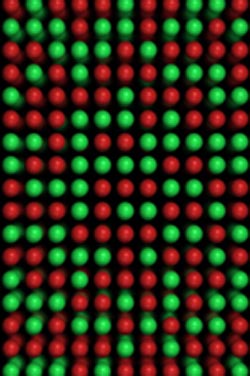Quantum Simulator for Complex Electronic Materials

An artists impression of the fermionic Mott insulating state: Due to the dominating repulsive interaction every lattice site is occupied by exactly one atom. The different colors indicate different spin states. Universität Mainz<br>
The design of new materials with specific properties is a difficult and important challenge in physics and chemistry. Nobel Prize winner Richard P. Feynman in 1982 therefore suggested to build a “quantum simulator” in order to understand and predict the properties of complex materials by simulating them using an artificial, but highly controllable different quantum system. In the latest issue of the journal Science a team of scientists led by Prof. Immanuel Bloch, director at MPQ and chair of physics at the Johannes Gutenberg Universität of Mainz show how to simulate the properties of electrons in a real crystal by using ultracold atoms trapped in an artificial crystal formed by interfering laser beams – a so called optical lattice. The researchers from the University of Mainz, the University of Cologne and the Forschungszentrum Jülich succeeded in demonstrating one of the most dramatic effects of the electron-electron repulsion: When the interactions between the electrons get too strong, a metal can suddenly become insulating. The resulting so-called Mott-insulator is probably the most important example of a strongly correlated state in condensed matter physics, and it is a natural starting point for the investigation of quantum magnetism. In addition, high temperature superconductivity is found to arise in close proximity to it.
“Atoms in an optical lattice are a nearly perfect quantum simulator for electrons in a solid, as they offer a very flexible model-system in a clean and well-controlled environment” explains Ulrich Schneider from the University of Mainz. Investigating complex materials and high temperature superconductors is difficult because of the presence of disorder and many competing interactions in the real crystalline materials. “This makes it difficult to identify the role of specific interactions and, in particular, to decide whether repulsive interactions between fermions alone can explain high temperature superconductivity” says Prof. Bloch.
In the experiment, a gas of potassium atoms is first cooled down to almost zero temperature. Subsequently, an optical lattice is created by overlapping several laser beams. To the atoms, the resulting standing-wave laser field appears as a regular crystal of tens of thousands of individual micro-traps, similar to an array of optical tweezers. The ultracold atoms, which assume the role of electrons in real solids, will line up at the nodes of this standing-wave field.
By investigating the behaviour of the atoms under compression and increasing interaction strength, and thereby measuring their compressibility, the experimentalists have been able to controllably switch the system between metallic and insulating states of matter and find evidence for a Mott-insulating phase within the quantum gas of fermionic atoms. In such a Mott insulating phase, the repulsive interactions between the atoms force them to order one-by-one into the regular lattice structure.
The observation of the fermionic Mott-insulator in the context of optical lattices opens up a new possibility to simulate and study strongly correlated states and related phenomena. This is affirmed by the excellent agreement achieved in comparing the experiment with theoretical calculations of modern condensed matter theory performed in Cologne and Jülich, which included extensive simulations on the Jülich based supercomputer system JUGENE. [I.B.]
Original publication:
U. Schneider, L. Hackermüller, S. Will, Th. Best, and I. Bloch,
T.A. Costi, R.W. Helmes, D. Rasch, and A. Rosch
“Metallic and Insulating Phases of Repulsively Interacting Fermions in a 3D Optical Lattice”
Science, 5th December 2008
More information and picture gallery:
www.quantum.physik.uni-mainz.de/bec
Contact:
Prof. Dr. Immanuel Bloch
Max-Planck-Institut für Quantenoptik
Hans-Kopfermann-Str. 1
D-85748 Garching, Deutschland
Phone: (+ 49 89) 32905 – 238
Fax: (+ 49 89) 32905 – 760
E-mail: immanuel.bloch[a]
Johannes Gutenberg-Universität Mainz
Staudingerweg 7
D 55128 Mainz
Phone: (+49 6131) 39-26234 / 22279
Fax: (+49 6131) 39-25179
E-mail: Bloch[a]Uni-Mainz.DE
Media Contact
All latest news from the category: Physics and Astronomy
This area deals with the fundamental laws and building blocks of nature and how they interact, the properties and the behavior of matter, and research into space and time and their structures.
innovations-report provides in-depth reports and articles on subjects such as astrophysics, laser technologies, nuclear, quantum, particle and solid-state physics, nanotechnologies, planetary research and findings (Mars, Venus) and developments related to the Hubble Telescope.
Newest articles

Innovative 3D printed scaffolds offer new hope for bone healing
Researchers at the Institute for Bioengineering of Catalonia have developed novel 3D printed PLA-CaP scaffolds that promote blood vessel formation, ensuring better healing and regeneration of bone tissue. Bone is…

The surprising role of gut infection in Alzheimer’s disease
ASU- and Banner Alzheimer’s Institute-led study implicates link between a common virus and the disease, which travels from the gut to the brain and may be a target for antiviral…

Molecular gardening: New enzymes discovered for protein modification pruning
How deubiquitinases USP53 and USP54 cleave long polyubiquitin chains and how the former is linked to liver disease in children. Deubiquitinases (DUBs) are enzymes used by cells to trim protein…


